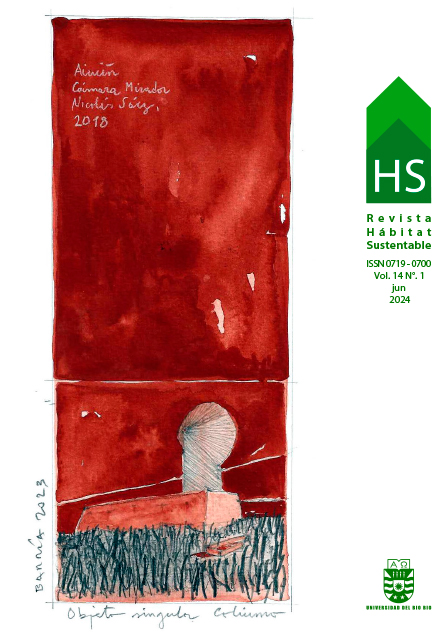Integration of circularity strategies into architectural design through BIM
DOI:
https://doi.org/10.22320/07190700.2024.14.01.09Keywords:
circular economy, materials recovery, circular transition scale, BIMAbstract
The construction industry represents a large part of the consumption of natural resources, with construction and demolition waste (CDW) projected to increase worldwide by 70% by 2050 if urgent measures are not taken. Applying circular economy in construction requires product selection in the design phase based on their circular potential, optimizing reuse to minimize waste. A mixed methodology is proposed, combining qualitative components and exploring how the actors involved in construction integrate multiple factors that influence the recovery of the material, assigning them percentage values that reflect the circular potential of the product. This quantitative information will be displayed graphically in BIM (Building Information Modeling), obtaining a synthetic quantification of the percentage of CDW. The circularity of the study model is compared with a more favorable one and a less favorable one, detecting substantial differences in circularity and determining the CDW percentage to formulate informed designs.
Downloads
References
AKANBI, L. A., OYEDELE, L. O., AKINADE, O.O., AJAYI, A. O., DÁVILA DELGADO, M., BILAL, M., y BELLO, S. A. (2018). Salvaging building materials in a circular economy: A BIM-based whole-life performance estimator. Resources, Conservation and Recycling, 129, 175-186. https://doi.org/10.1016/j.resconrec.2017.10.026
CALZOLARI, T., GENOVESE, A., y BRINT, A. (2022) Circular Economy indicators for supply chains: A systematic literature review. Environmental and Sustainability Indicators, 13, 100160. https://doi.org/10.1016/j.indic.2021.100160
CLIMENT, A. (2021). Economía circular aplicada a la arquitectura espejismo o realidad. Limaq, 7(007), 29-71. https://doi.org/10.26439/limaq2021.n007.5178
Corantioquia. (2022). Política Nacional de Producción y Consumo Sostenible. Negocios Verdes Crecim. Sosten., 33, pp. 820–830
DUFRENE, M., ZWOLINSKI, P., y BRISSAUD, D. (2013). How the Integration of Environmental Concerns Modifies the Integrated Design Process. In: Abramovici, M., Stark, R. (eds) Smart Product Engineering. Lecture Notes in Production Engineering. Springer, Berlin, Heidelberg. pp. 845-854. https://doi.org/10.1007/978-3-642-30817-8_83
ENSHASSI, A., KOCHENDOERFER B., y RIZQ E. (2014). An evaluation of environmental impacts of construction projects. Revista Ingeniería de Construcción, 29(3), 234–254. http://dx.doi.org/10.4067/S0718-50732014000300002
FERNÁNDEZ, R., y RAPOSO, J. (2022). Economía circular y BIM. Optimización, sostenibilidad y construcción [Trabajo de Fin de Grado]. Universidad Politécnica de Madrid.
FIEL M. (2022). Sustainable and Eco-Effective Architecture: Pushing BIM Limits with a Cradle-to-Cradle Approach. Aus, (32), 12–19. https://doi.org/10.4206/aus.2022.n32-03
GHISELLINI, P., JI, X., LIU, G., y ULGIATI, S. (2018). Evaluating the transition towards cleaner production in the construction and demolition sector of China: A review. Journal of Cleaner Production, 195, 418-434. https://doi.org/10.1016/j.jclepro.2018.05.084
JRADE, A., y JALAEI, F. (2014). Integrating Building Information Modeling (BIM) and energy analysis tools with green building certification system to conceptually design sustainable buildings. Journal of Information Technology in Construction, 19, 494–519. https://www.itcon.org/2014/29
MESA, J., ESPARRAGOZA, I., y MAURY, H. (2018) Developing a set of sustainability indicators for product families based on the circular economy model. Journal of Cleaner Production, 196, 1429-1442. https://doi.org/10.1016/j.jclepro.2018.06.131
MERCADER MOYANO, M., CAMPOREALE, P. E., y CÓZAR-CÓZAR, E. (2019). Indicadores a Un Modelo Bim De Vivienda Social. Hábitat Sustentable, 9(2), 78–93. https://doi.org/10.22320/07190700.2019.09.02.07
MORA, D. (2021). Reciclaje y reutilización de materiales de construcción en Colombia como aporte a la economía circular [Tesis Ingeniería Civil]. Universidad de La Salle, Bogotá.
NIERO, M., y KALBAR, P. P. (2019). Coupling material circularity indicators and life cycle based indicators: A proposal to advance the assessment of circular economy strategies at the product level. Resources, Conservation and Recycling, 140, 305-312. https://doi.org/10.1016/j.resconrec.2018.10.002
OSSIO, F. (2021). Políticas para la implementación de una estrategia circular en la construcción, cap. 6 en Propuestas para Chile. Concurso de Políticas Públicas, Centro de Políticas Públicas UC, Santiago.
POTTING, J., HEKKERT, M.P., WORRELL, E., y HANEMAAIJER, A. (2017). Circular Economy: Measuring Innovation in the Product Chain. Technical Report
PRIETO-SANDOVAL, V., JACA-GARCÍA, C., y ORMAZABAL-GOENAGA, M. (2017). Economía circular: Relación con la evolución del concepto de sostenibilidad y estrategias para su implementación. Memoria de Investigaciones en Ingeniería, 15, 85-95. https://hdl.handle.net/10171/53653
SALEHABADI, Z. M., y RUPARATHNA, R. (2022). User-centric sustainability assessment of single family detached homes (SFDH): A BIM-based methodological framework. Journal of Building Engineering, 50, 104139. https://doi.org/10.1016/j.jobe.2022.104139
ZHANG, K., y JIA, J. (2021). Promotion of the Application of BIM in China—A BIM-Based Model for Construction Material Recycling. Recycling, 6(1), 16. https://doi.org/10.3390/recycling6010016
Downloads
Published
How to Cite
Issue
Section
License
Copyright (c) 2024 Viviana Duran-Navarrete, Rodrigo García-Alvarado, Mabel Vega-Coloma

This work is licensed under a Creative Commons Attribution-ShareAlike 4.0 International License.
The content of articles which are published in each edition of Habitat Sustentable, is the exclusive responsibility of the author(s) and does not necessarily represent the thinking or compromise the opinion of University of the Bio-Bio.
The author(s) conserve their copyright and guarantee to the journal, the right of first publication of their work. This will simultaneously be subject to the Creative Commons Recognition License CC BY-SA, which allows others to share-copy, transform or create new materials from this work for non-commercial purposes, as long as they recognize authorship and the first publication in this journal, and its new creations are under a license with the same terms.











 Scientific Information Program/Concurso Fondos de Publicación de Revistas Científicas 2018/ Proyecto Mejoramiento de Visibilidad de Revistas UBB (Código:FP180007).
Scientific Information Program/Concurso Fondos de Publicación de Revistas Científicas 2018/ Proyecto Mejoramiento de Visibilidad de Revistas UBB (Código:FP180007).





